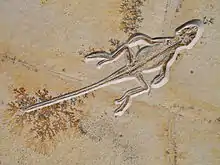| Homoeosaurus Temporal range: Late Jurassic - Early Cretaceous | |
|---|---|
 | |
| Homoeosaurus maximiliani | |
| Scientific classification | |
| Domain: | Eukaryota |
| Kingdom: | Animalia |
| Phylum: | Chordata |
| Class: | Reptilia |
| Order: | Rhynchocephalia |
| Clade: | Neosphenodontia |
| Genus: | †Homoeosaurus von Meyer, 1847 |
| Species | |
| |
Homoeosaurus is an extinct genus of rhynchocephalian reptile, known from the Late Jurassic-earliest Cretaceous of Europe, with specimens being reported from France (Canjuers Lagerstatte), England (Purbeck Group) and Germany (Solnhofen Limestone). Several species have been described within the genus, based on varying proportions of the limb bones to the body length based on the presacral vertebrae. Specimen C.M.6438 of H. maximiliani from Germany has a total length of around 17 centimetres (6.7 in), with a skull length of about 1.7 centimetres (0.67 in). In comparison to other rhynchocephalians, the limbs are proportionally long.[1] Recent studies have classified Homoeosaurus as a member of Neosphenodontia, with some studies including it as part of the clade Leptorhynchia, also including sapheosaurs, pleurosaurs, Kallimodon and Vadasaurus.[2] Despite being found in aquatic deposits, it is suggested to have been terrestrial.[3] It is thought to have been a carnivore/insectivore.[4] One specimen was found as stomach contents of the fish Belonostomus.[5]
References
- ↑ Wu X-C. The comparative anatomy and systematics of Mesozoic sphenodontians. Ph.D. Thesis, McGill University. 1991. p. 84-113.
- ↑ DeMar, David G.; Jones, Marc E. H.; Carrano, Matthew T. (2022-12-31). "A nearly complete skeleton of a new eusphenodontian from the Upper Jurassic Morrison Formation, Wyoming, USA, provides insight into the evolution and diversity of Rhynchocephalia (Reptilia: Lepidosauria)". Journal of Systematic Palaeontology. 20 (1): 1–64. doi:10.1080/14772019.2022.2093139. hdl:2440/136608. ISSN 1477-2019. S2CID 252325953.
- ↑ Reynoso, Víctor-Hugo (2005-09-30). "Possible evidence of a venom apparatus in a Middle Jurassic Sphenodontian from the Huizachal red beds of Tamaulipas, México". Journal of Vertebrate Paleontology. 25 (3): 646–654. doi:10.1671/0272-4634(2005)025[0646:PEOAVA]2.0.CO;2. ISSN 0272-4634. S2CID 131602253.
- ↑ Rauhut, Oliver W. M.; Heyng, Alexander M.; López-Arbarello, Adriana; Hecker, Andreas (2012-10-31). Farke, Andrew A. (ed.). "A New Rhynchocephalian from the Late Jurassic of Germany with a Dentition That Is Unique amongst Tetrapods". PLOS ONE. 7 (10): e46839. Bibcode:2012PLoSO...746839R. doi:10.1371/journal.pone.0046839. ISSN 1932-6203. PMC 3485277. PMID 23118861.
- ↑ Frey, Eberhard; Tischlinger, Helmut (2012-03-07). Fenton, Brock (ed.). "The Late Jurassic Pterosaur Rhamphorhynchus, a Frequent Victim of the Ganoid Fish Aspidorhynchus?". PLOS ONE. 7 (3): e31945. Bibcode:2012PLoSO...731945F. doi:10.1371/journal.pone.0031945. ISSN 1932-6203. PMC 3296705. PMID 22412850.